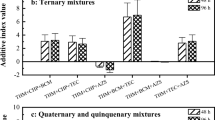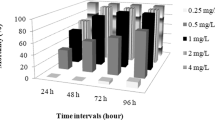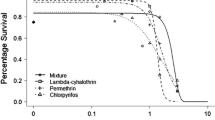Abstract
Synthetic pyrethroids often have synergists added to improve effectiveness, yet decisions regarding the use of these pesticides are often based upon toxicity tests using technical material without the synergist, piperonyl butoxide. We conducted toxicity tests with brook trout (Salvelinus fontinalis) and brown trout (Salmo trutta) to compare the toxicity of synergized and technical formulations of permethrin, sumithrin, and resmethrin. We found a significant increase in toxicity in the synergized permethrin formulation using traditional 24, 48, and 96-h tests, relative to tests with the technical formulation. However, there was little difference in toxicity between synergized and technical sumithrin until 48 h had elapsed. Many test fish were strongly intoxicated by either formulation of permethrin or sumithrin, but the synergized formulations of both chemicals affected fish at lower concentrations. Intoxication was potentially severe enough to reduce the survival of these fish in the wild. Following short (6-h) exposures, we also found a larger difference in the number of fish that died or became intoxicated between the synergized and technical formulations of permethrin and sumithrin. Finally, we tested the ability of exposed fish to swim against a current. Fish exposed for 6 h to synergized permethrin and resmethrin had far less swimming stamina than those exposed to technical formulations. We found no difference in the effect on swimming between the synergized and technical formulation of sumithrin. In general, the synergized formulations of these chemicals appeared to cause a faster response than the technical formulations. This response increases the lethal and sublethal impacts of the insecticides. We also found that sumithrin was the least toxic of the three pyrethroids. Since the maximum application rate of sumithrin is half that of the other two pyrethroids, the potential risk to wild trout in streams may be reduced.




Similar content being viewed by others
References
6NYCRR (1998) Title 6 (Environmental Conservation) of New York’s Official Compilation of Codes, Rules and Regulations (6NYCRR) Part 326 Restricted Pesticides, Section 326.14 General Requirements for Pesticide Product Registration, amended 11/13/1998
40 CFR Part 158 (2002) United States Code of Federal Regulations, Title 40, Protection of Environment, Chapter I—Environmental Protection Agency, Part 158—Data Requirements for Registration, Subpart D, Data Requirement Tables, revised as of July 1, 2002
RA Bachman (1984) ArticleTitleForaging behavior of free-ranging wild and hatchery brown trout in a stream Trans Am Fish Soc 113 1–32
JR Brett NR Glass (1964) ArticleTitleThe respiratory metabolism and swimming performance of young sockeye salmon J Fish Res Bd Can 21 1183–1226
JE Casida (1980) ArticleTitlePyrethrum flowers and pyrethroid insecticides Environ Health Perspect 34 189–202
JR Coats NL O’Donnell-Jeffery (1979) ArticleTitleToxicity of four synthetic pyrethroid insecticides to rainbow trout Bull Environ Contam Toxicol 23 250–255
JR Colquhoun HA Simonin HJ Dean J Symula (1984) ArticleTitleSwimming performance of juvenile brown trout exposed to acutely sublethal concentrations of naled N Y Fish Game J 31 133–137
Dean HJ, Ford ME (1983) Final programmatic environmental impact statement on Northern New York black fly and mosquito control. Town of Webb, Old Forge, NY
J-P Demoute (1989) ArticleTitleA brief review of the environmental fate and metabolism of pyrethroids Pestic Sci 27 375–385
DA Erickson MS Goodrich JJ Lech (1988) ArticleTitleThe effect of piperonyl butoxide on hepatic cytochrome P-450-dependent monooxygenase activities in rainbow trout (Salmo gairdneri) Toxicol Appl Pharmacol 94 1–10
DJ Finney (1978) Statistical method in biological assay EditionNumber3 Charles Griffin and Co Ltd London
MA Hamilton RC Russo RV Thurston (1977) ArticleTitleTrimmed Spearman-Karber method for estimating median lethal concentrations Environ Sci Tech 11 714–719
HBN Hynes (1970) The ecology of running waters University of Toronto Press Ontario
Johnson WW, Finley MT (1980) Handbook of acute toxicity of chemicals to fish and aquatic invertebrates. Resource Publication 137, US Fish and Wildlife Service, Washington, DC
AL Jolly JW Avault KL Koonce JB Graves (1978) ArticleTitleAcute toxicity of permethrin to several aquatic animals Trans Am Fish Soc 107 825–827
AK Kumaraguru FWH Beamish (1981) ArticleTitleLethal toxicity of permethrin (NRDC-143) to rainbow trout, Salmo gairdneri, in relation to body weight and water temperature Water Res 15 503–505
AK Kumaraguru FWH Beamish (1983) ArticleTitleBioenergetics of acclimation to permethrin (NRDC-143) by rainbow trout Comp Biochem Physiol 75C 247–252
FJ Kutka (1994) ArticleTitleLow pH effects on swimming activity of Ambystoma salamander larvae Environ Toxicol Chem 13 1821–1824
DW McLeese CD Metcalfe V Zitko (1980) ArticleTitleLethality of permethrin, cypermethrin and fenvalerate to salmon, lobster and shrimp Bull Environ Contam Toxicol 25 950–955
W Mendenhall (1975) Introduction to probability and statistics, 4th ed Duxbury Press North Scituate, Massachusetts
J Miyamoto (1976) ArticleTitleDegradation, metabolism and toxicity of synthetic pyrethroids Environ Health Perspect 14 15–28
Office of Pesticide Programs (1995) Environmental Effects Database (EEDB) Environmental Fate and Effects Division, US EPA, Washington, DC
Paul EA (1997) Water quality and reference toxicant testing: a quality assurance report on toxicity testing conducted by the aquatic toxicant research unit at the Rome Field Station. NYSDEC, Division of Fish and Wildlife, Bureau of Habitat Technical Report, August 15, 1997
EA Paul HA Simonin (1995) ArticleTitleComparison of the toxicity of a synergized and non-synergized insecticide to young trout Bull Environ Contam Toxicol 55 453–460
EA Paul HA Simonin (1996) ArticleTitleThe effects of naled, synergized, and non-synergized resmethrin on the swimming performance of young trout Bull Environ Contam Toxicol 57 495–502
JL Peterson PC Jepson JJ Jenkins (2001) ArticleTitleEffects of varying pesticide exposure duration and concentration on the toxicity of carbaryl to two field-collected stream invertebrates, Calineuria californica (Plecoptera: Perlidae) and Cinygma sp. (Ephemeroptera: Heptageniidae) Environ Toxicol Chem 20 2215–2223
SC Schimmel RL Garnas JM Patrick JC Moore (1983) ArticleTitleAcute toxicity, bioconcentration, and persistence of AC 222,705, Benthiocarb, Chlorpyrifos, fenvalerate, methyl parathion, and permethrin in the estuarine environment J Agricult Food Chem 31 104–113
Sprague JB, Fogels A (1977) Watch the Y in bioassay. Proceedings of 3rd Aquatic Toxicity Workshop, Halifax, NS, Nov. 2–3, 1976. Environmental Protection Service technical report no. EPS-5-AR-77-1, 107–118
West, Inc, Gulley DD (1996) TOXSTAT® Version 3.5. West Inc, Western EcoSystems Technology, Inc., Cheyenne, WY
WHO (1989) Resmethrins. Environmental Health Criteria 92. World Health Organization, Geneva
WHO (1990) d-Phenothrin. Environmental Health Criteria 96. World Health Organization, Geneva
DF Woodward EE Little LM Smith (1987) ArticleTitleToxicity of five shale oils to fish and aquatic invertebrates Arch Environ Contam Toxicol 16 239–246
Author information
Authors and Affiliations
Corresponding author
Rights and permissions
About this article
Cite this article
Paul, E.A., Simonin, H.A. & Tomajer, T.M. A Comparison of the Toxicity of Synergized and Technical Formulations of Permethrin, Sumithrin, and Resmethrin to Trout. Arch Environ Contam Toxicol 48, 251–259 (2005). https://doi.org/10.1007/s00244-003-0110-9
Received:
Accepted:
Published:
Issue Date:
DOI: https://doi.org/10.1007/s00244-003-0110-9




